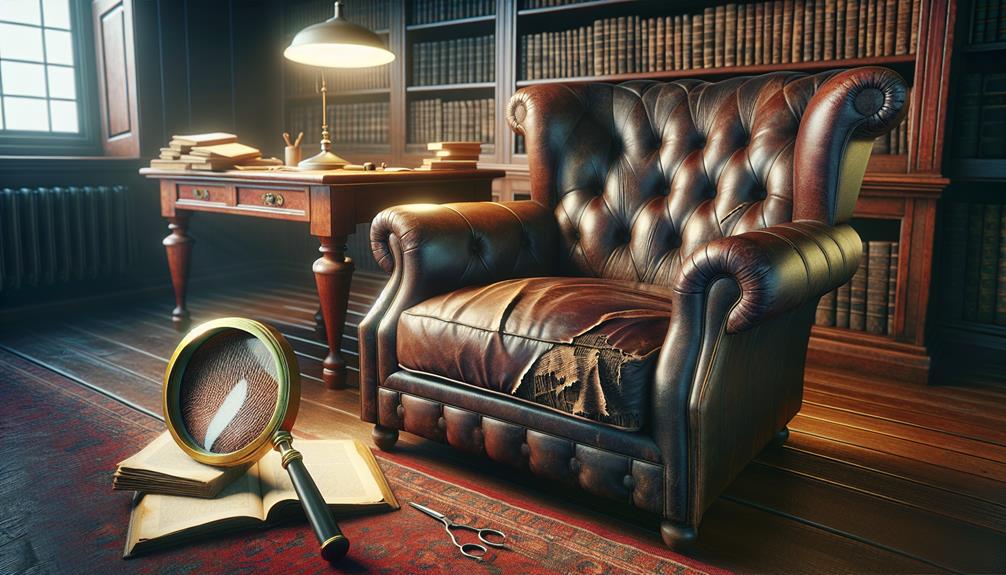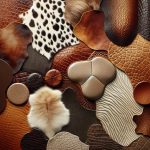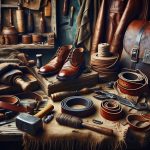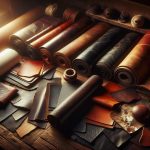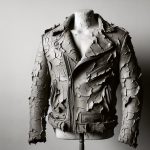Yes, leather is definitely good quality, especially when you choose the right type. Full-grain leather, for instance, is the best you can get—it's durable, ages well, and looks better over time. Sure, it's a bit pricier, but it's worth the investment because it lasts. You'll want to avoid bonded leather though; it's made from scraps and isn't very durable. Good leather also has a distinct smell and feel that's hard to replicate. If you're keen on something that develops character and endures, high-quality leather is the way to go. Stick around and see what sets good leather apart!
Table of Contents
Key Takeaways
- Leather's durability makes it a high-quality choice, lasting decades with proper care.
- Full-grain leather is particularly prized for its strength and ability to develop a rich patina.
- Quality leather features unique textures and imperfections, enhancing its aesthetic appeal.
- The environmental impact of leather production can be significant, involving water use and chemical tanning.
- Maintenance is crucial, as regular conditioning and careful use preserve leather's appearance and longevity.
Defining Leather Quality
When we talk about leather quality, factors like grade, texture, appearance, and smell play crucial roles. High-quality leather isn't just about looking good; it's about how it feels and lasts. It's soft, flexible, and gets better with age, developing a unique patina that tells its own story.
You can often tell it's high-quality by its imperfections. Things like wrinkles, scars, and color variations aren't flaws; they're signs of full grain leather, which is the real deal. This type of leather keeps its natural markings, and that's actually a good sign. It means the leather hasn't been sanded down or covered up to look uniform. Each piece is unique.
When I check out leather, I always give it a good sniff and feel. Genuine leather has a distinctive smell and feel that synthetic materials just can't match. If it smells rich and earthy, and feels sturdy yet supple, it's likely high-quality. Inspecting its structure closely also helps. If it maintains its color and texture well, you know you've got something authentic and durable. That's the kind of quality you want in leather.
Types of Leather
Let's talk about some specific types of leather and what makes them stand out.
We'll look at why full-grain leather is considered top-notch, what bonded leather really is, and how to take care of suede leather.
These insights can help you make better choices when shopping for leather products.
Full-Grain Leather Benefits
Full-grain leather, known for its luxury and minimal flaws, is the top choice for high-quality products. It's the highest quality leather you can get. This type of leather is super durable and keeps its shape because the grain layer is left intact. That means it's great for stuff like premium boots and fancy couches. What's cool is that full-grain leather gets better with age. It develops this nice patina that not only looks awesome but also adds extra protection.
Whether you choose aniline or semi-aniline finishes, you're enhancing the color and safeguarding your leather even more. So, if you're after a natural look, incredible durability, and something that ages gracefully, full-grain, high-quality leather is definitely the way to go.
Bonded Leather Overview
While full-grain leather offers premium quality, bonded leather provides a more affordable option. Let's dive into what bonded leather really is.
It's crafted from leftover leather scraps that are mashed up and bonded with a polyurethane binder. This means it only contains about 10-20% genuine leather. Because of its makeup, bonded leather is less durable and tends to peel or flake over time. It just doesn't hold up like real leather does.
If you're on a tight budget, bonded leather might seem tempting. However, it's important to consider its poor quality and shorter lifespan. It mightn't give you the bang for your buck if longevity and durability are what you're after.
Caring for Suede Leather
Suede leather, known for its softness and delicate texture, needs careful handling to stay looking its best. This natural leather is softer than most because it comes from the underside of the hide. It's all about the care you put in.
| Action | Purpose | How Often |
|---|---|---|
| Brushing | Remove dirt, restore nap | Regularly |
| Protecting | Avoid water and stains | Before exposure |
| Storing | Keep in a dry, cool place | Always |
I make sure I'm gentle when I clean and store my suede items. Keeping them dry and brushing them softly does the trick. It's simple, but it's crucial for maintaining that premium look and feel.
Durability of Leather
Let's talk about how long leather products can last.
I'll also share some easy tips on how to keep your leather in top shape.
Knowing this can help you make the most out of your leather items.
Longevity of Leather Products
High-quality leather products really stand the test of time, often lasting for decades with the right care. Let's dive into why leather is such a durable choice:
- Natural Strength: Leather's toughness makes it ideal for everyday items like bags and shoes that take a beating but keep on ticking.
- Ages Gracefully: Good leather, especially full-grain leather, develops a patina over time. This isn't just about looking better; it actually enhances the material's character and resilience.
- Self-healing Properties: Minor scratches? No big deal. Leather can self-repair, keeping your items looking fresh longer.
In short, investing in leather means you're getting a companion that grows and improves with age. It's a win-win!
Leather Maintenance Tips
Why should you care about maintaining your leather goods? Well, keeping your leather in top shape ensures it lasts longer and stays looking great. You've got to regularly wipe down your items with a soft, damp cloth. This simple step removes dirt and keeps the leather's quality high. Don't forget to condition your leather every six months or so. It prevents the material from drying and cracking, keeping it supple.
Store your leather stuff in a cool, dry place. Sunlight and heat can mess it up, fading its natural color and weakening its structure. Lastly, use a protectant spray. It guards against water and stains, making your leather more durable. So, a little care goes a long way!
Leather Maintenance
Maintaining your leather goods requires regular cleaning and conditioning to keep them looking their best. I've learned that leather maintenance isn't just about making your items last longer; it's about preserving the quality and ensuring they age gracefully. Here's how I tackle it:
- Regular Cleaning: I always start by gently wiping my leather items with a soft, damp cloth. This simple step removes dust and dirt that can scratch the surface over time. It's crucial not to soak the leather, just a quick swipe!
- Conditioning: After cleaning, I apply a good leather conditioner. This step keeps the leather soft and prevents it from drying out and cracking. Think of it as moisturizing your skin; leather needs hydration to stay supple.
- Proper Storage: I make sure to store my leather goods in a cool, dry place away from direct sunlight. This helps prevent the leather from fading and maintains its vibrant color.
Price Comparison
After covering how to care for leather, let's look at how much you might spend on high-quality leather goods. Investing in high-quality leather, like full grain leather or top grain leather, typically costs more upfront but proves to be a smarter choice over time. These materials are known for their durability and ability to age beautifully.
However, if you come across a leather product with a price that seems too good to be true, it probably is. Lower prices often suggest lower quality materials, which might not last as long. It's important to remember that the price can be a good indicator of the quality of leather used.
Here's a simple table to help you understand the typical price differences:
| Quality Type | Example Product | Price Range |
|---|---|---|
| Full Grain Leather | Leather Jacket | $250 – $500 |
| Top Grain Leather | Leather Wallet | $100 – $200 |
| Lower Quality Leather | Leather Belt | $20 – $50 |
As you can see, the better the quality, like full grain and top grain, the higher the price. But consider this an investment—these pieces often outlast their cheaper counterparts, giving you more bang for your buck in the long run.
Environmental Impact
While leather products offer durability and aesthetic appeal, their production poses serious environmental challenges. The environmental impact of producing leather is significant, and as someone keen on understanding these effects, it's crucial to dig deeper into this issue.
Here's what you need to know:
- Water and Chemical Use: Leather production is notoriously water-intensive, consuming large quantities for processing. Moreover, the chemicals used, especially in traditional tanning methods involving chromium, are harmful. These substances can contaminate local water sources, affecting both ecosystems and human health.
- Deforestation: The demand for grazing land is another major concern. As the need for livestock grows to meet leather supply, vast areas of forest are cleared. This deforestation not only disrupts habitats but also contributes to climate change.
- Sustainable Alternatives: On a positive note, adopting sustainable practices can mitigate some of these impacts. Vegetable-tanned leather, for instance, uses natural materials instead of harsh chemicals, offering a less damaging option.
Understanding these points helps us grasp the full picture of leather's environmental footprint. It's about making informed choices and considering alternatives that align with environmental conservation efforts.
Leather Aesthetics
Why do so many people cherish leather for its unique aesthetics? Well, it's all about the imperfections and the texture. Each piece of high-quality leather showcases its own story through blemishes, scars, and color variations. These aren't flaws; they're proofs of authenticity and natural origin. You just don't get that with synthetic materials.
The texture of leather is another big pull. It's soft, flexible, and smooth, feeling luxurious under your fingertips. This isn't just about looking good; it's about feeling good too. Over time, genuine leather even gets better. It develops a rich patina that deepens its color and enhances its beauty. It's like it ages gracefully, getting more charming with every year.
What's fascinating is how these qualities – the imperfections and the evolving texture – combine to create something truly distinctive. No two leather items are exactly alike. Each has its unique character, influenced by natural factors like veins or even insect bites. It's this individuality that makes leather not just a material but a narrative piece, rich in history and personality. Leather isn't just about covering something up; it's about showcasing raw, natural beauty.
Leather Smell Test
Building on its visual and tactile appeal, the distinctive scent of leather also plays a key role in its allure. When I'm checking out leather items, the smell of real, authentic leather is one of the first things I notice. It's a game-changer. Leather is soft and carries a rich, sweet fragrance that's hard to replicate.
Here's a quick guide on how to do a smell test:
- Identify the Sweetness: High-quality leather should have a rich, sweet smell resulting from the natural oils, perfumes, and waxes used during tanning. Vegetable-tanned leather typically smells sweeter than chrome-tanned.
- Check for Chemical Odors: If you sniff out a plastic or chemical scent, chances are it's not genuine leather. Fake leather often has a synthetic smell due to the materials and chemicals used in its production.
- Longevity of Scent: Genuine leather maintains its distinctive scent over time. If the leather item still smells good months or even years later, it's likely the real deal.
Understanding these aspects can really elevate your leather shopping game. It's not just about how it looks or feels; how it smells can tell you a lot about its quality too!
Water Resistance Levels
Testing leather's water resistance can reveal a lot about its quality. High-quality leather, being a natural material, has pores that absorb liquids. This isn't just a quirk—it's a sign of authenticity and good quality. If you drip some water on genuine leather, you'll notice it slowly soaks in. This shows it's the real deal.
On the other hand, if the leather repels water, it might be of lower quality or even a fake. Not all leather goods will let you test this in the store, but it's a handy trick if you can manage it. Remember, water resistance is a big clue about leather's durability and overall worth.
Keep in mind that while absorbing water indicates quality, it doesn't mean all high-quality leather must get soaked. Different treatments and finishes can alter how a leather piece handles moisture. But at its core, the ability to absorb liquids helps confirm the leather's natural and genuine character.
Leather Stitching Details
When examining leather goods, it's crucial to check the stitching details for signs of quality and durability. The way a leather product is stitched together can tell you a lot about how long it'll last and how well it's made.
Here are three key points to look out for:
- Thread Quality: Always check if high-quality thread is used, like German-spun marine-grade polyester. This type of thread ensures the stitching won't easily break or decay.
- Stitching Technique: Notice if the product uses machine or hand stitching. Hand stitching, which typically uses a single thread, offers more durability than machine stitching that uses two threads. This single thread technique reduces the chances of the stitch breaking from one point.
- Uniformity and Neatness: Look closely at the stitching lines. Are they straight and uniform? Avoid leather goods with wandering threads or messy stitches on the bottom, as these are signs of poor craftsmanship.
Choosing Quality Leather Products
When picking out leather goods, it's crucial to understand the different grades of leather and how they affect durability.
Knowing how to care for leather items also helps them last longer and stay beautiful.
Let's talk about what to look for and how to keep your leather in top shape.
Types of Leather Grades
Let's dive into the different grades of leather to better understand what to look for when choosing quality leather products. Knowing about these grades can really make a difference! Here's a quick rundown:
- Full-Grain Leather: It's the top dog in the leather world, known for its durability and the way it ages gracefully, developing a unique patina over time.
- Top-Grain Leather: A tad below full-grain, this leather is treated to resist stains better and is more flexible, making it quite popular for everyday use.
- Genuine Leather: Despite being real leather, it's not as high on the quality scale. It's made from the remnants of other leather grades, so it doesn't hold up as well or look as nice.
Choosing the right grade really matters!
Leather Durability Factors
Quality leather's durability hinges on its natural fibers and intact grain structure. When I'm picking out leather goods, I always look for full-grain options. This type of leather keeps the top layer unaltered, showcasing all its natural markings — a sign of real, tough material ready to stand the test of time.
Here's a quick breakdown to help you understand why full-grain tops the chart:
| Quality Aspect | Full-Grain Leather | Other Types |
|---|---|---|
| Surface Integrity | Untouched | Often Altered |
| Durability | Highest | Variable |
| Wear Resistance | Excellent | Less Predictable |
Choosing high-quality leather means you're investing in something that not only looks good but also lasts longer. Always check the label!
Caring for Leather Items
To keep your leather items in prime condition, you should invest in proper care products like conditioners and protectants. Genuine leather, especially the full-grain or top-grain types, really stands up to wear if you treat it right. Here's how I make sure my leather stays top-notch:
- Choose Quality: I always go for handcrafted leather goods. The craftsmanship is a game-changer.
- Regular Maintenance: I use leather care products regularly. Conditioning and protecting my leather keeps it from drying or cracking.
- Avoid Damage: I keep my leather away from too much sun and never let it soak up water.
Taking these steps ensures my leather items look great and last a long time.
Frequently Asked Questions
What Are the Negatives of Leather?
Leather's negatives include its environmental impact from production, harmful tanning chemicals, and ethical concerns around animal welfare. It also requires frequent maintenance to avoid damage like cracking and discoloration.
How Can You Tell if Leather Is Good Quality?
I look for imperfections like wrinkles and scars, which show it's real. High-quality leather feels soft and smells rich. It should also keep its color and shape when exposed to heat.
What Is the Highest Quality Leather?
In my experience, the highest quality leather is full-grain leather. It's got a natural surface, lasts ages, and feels premium. Top-grain's next, still good but a bit more processed.
What Is the Lifespan of Leather?
Leather's lifespan varies greatly. High-quality full-grain leather can last decades with care, while lower grades like genuine leather may not endure as long. Proper maintenance significantly extends its durability and appearance.
- Is Tencel Lyocell Expensive? - April 20, 2024
- Which Is Better Tencel or Lyocell? - April 19, 2024
- What Are the Disadvantages of Lyocell? - April 19, 2024

